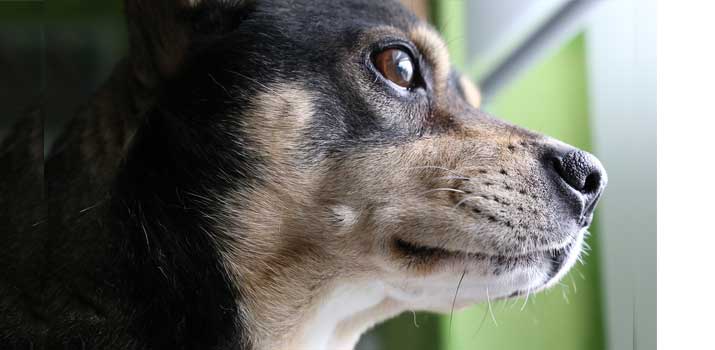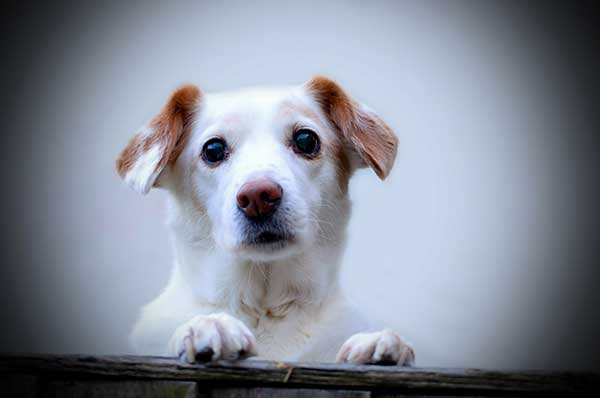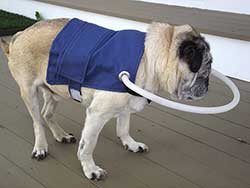Dogs are pretty resilient creatures! They can get by even in the toughest situations, using their senses to navigate the world and come up with a solution. That said, going blind is still a big change.
While canines rely on their sense of sight much less than we humans do, losing their eyesight can be a pretty difficult situation to get through. This is especially true if the loss occurs suddenly. It's a dramatic shift in the way they live.
Most dogs will adapt well with time, but they need their owners' support to get there.

The truth is: Owners usually have a harder time dealing with their dogs going blind than they do. No pet parent wants to see their canine companion as anything but perfect. When they start struggling to see what's in front of them, it can be heart-wrenching.
The good news is that living with a blind dog isn't as hard as some would think. After you get over the initial hardships, it's just like living with a seeing dog. The only difference is that you have to adapt to this unique handicap.
Your pooch will still be the loving creature they always were! With the right care, they may even go back to being playful and rambunctious.
What to Expect When Your Dog is Going Blind
Before we get into how you can adapt your home and lifestyle to cater to your blind dog, let's talk about the events leading to the loss of sight. Blindness can affect any dog. It can occur after a physical accident, or it might be a symptom of a disease.
Gradual Blindness
If your dog is going blind slowly, you will likely see the symptoms early on. Behavioral changes are quite common. Dogs often have difficulty finding their favorite toys or navigating to their bed.
Interestingly enough, many also become low-energy and lethargic. It's not so much a matter of low energy levels. In most cases, the perceived lethargy stems from fear!
Dogs who can't see are naturally scared, so they don't venture out so much for fear of getting hurt. They might also get startled easier, as they don't see things coming like they once did.
Physically, you might notice some changes, too. The eyes often become cloudy or discolored. Your dog may also exhibit signs of pain in bright environments.
Sudden Blindness
The symptoms of sudden blindness are the same as the ones with gradual blindness. The difference is that they all occur at once, which can be a traumatic experience.
Dogs that go blind out of nowhere will often be super clumsy and fearful. They might cower at every sound. The sudden darkness they're experiencing is brand-new, so unpredictable behavior is to be expected.
Related: Dog’s Eye Got Scratched by a Cat
13 Ways to Help Your Dog Adapt
Whether the blindness is gradual or sudden, it's always a good idea to visit your vet. Your vet can perform a full diagnosis and see if there's anything they can do to restore vision.
Whatever the case may be, don't fret. The immediate aftermath of going blind can be a little scary for both you and your dog.
Your pooch might become a little anxious and scared as they adapt to this new normal. But over time, most dogs will have no problem living a happy and healthy life.
Of course, a few changes can make the adjustment much easier. Here are a few things that you can do to make things easier for your blind dog.

#1. Make Your Home Safer
The first thing you should do is dog-proof your home! Your dog probably has a pretty good run of the land already. But there's still going to be some adjusting here and there.
Accidents and injuries are a genuine possibility, so you need to do your part to ensure that they don't happen.
Block off stairs and entrances to risky spots, such as a pool or garage. Also, pay attention to sharp corners your dog could accidentally bump into. Baby-proofing kits are your best friend here! Look for every possible hazard and do your part to make things safer.
#2. Create a Safe Haven
Once you dog-proof the home, create a little haven for your dog to go whenever they start feeling overwhelmed. Adjusting to blindness will take a toll on your dog's emotions. They can easily become anxious and stress-out. Having a place to relax and find some peaceful solace is a must.
If they already have a favorite room or kennel, use that as the base. Then, add some pillows, blankets, and fun toys. Put all of their comfort items in one place that they can easily find.
We also recommend putting an old shirt or pillowcase infused with your scent. Anything that makes them feel comfortable and at-home will do.
#3. Stick to the Same Old Routine
Here's something that not too many owners consider: Your dog can get around your home pretty well! They've spent years walking from room to room.
They know how to find their dish, where the door to the backyard is, and more.
Don't go changing things around! Your dog needs that little ounce of comfort they have. Suddenly moving their water dish to another room will only throw them off and set back their progress.
Stick to the same routine and try to proceed with life as normal. Your dog will benefit from the "regularly scheduled programming."
#4. Provide Physical Barriers and Cues
Now that your dog can't use its sight to navigate the world, it'll have to use its other senses. One of the best things you can do for your dog is to create tactile experiences around key points in your home.
These tactile areas will send a message through touch, acting as a warning to things they would normally see with their eyes.
You can get creative here and create tactile experiences throughout the house. But the most important places are on staircases and doors.
Place a small rug or carpet strip at the bottom and top of the stairs. Use some gravel or rocks around the gate to your yard. Those little details will make a world of difference.
#5. Talk to Your Dog Often
Don't leave your dog in the dark! Speak to your pup frequently. You are their most trusted companion, and they'll be listening for your presence at every turn.
Whenever they feel scared or confused, your voice will be the beacon of light in the dark.
Regular conversations with your dog can also alert them of your presence. It's important to talk to them before you go in for a pet or head scratch. Otherwise, the sudden physical contact will just scare them.
#6. Use Audible Cues
If you're used to a quiet home, be prepared to infuse some noise into the mix. Sound is an important cue for blind dogs. Use it to your advantage!
Attach little bells onto other pets and create small audible cues throughout the home. You can also wear loud shoes or attach chimes on doors. Whatever the case may be, those cues will have a huge impact.
They keep your dog in-tune with what's going on around them. Plus, it helps them navigate your home and figure out where things are.
#7. Take Advantage of Their Sense of Smell
Your pup's sense of smell is going to get even stronger if they lose their sight. Take advantage of those olfactory senses whenever you're out and about.
If your dog is using a toy, consider rubbing a treat on it or dropping some essential oils. When they lose touch with it, the scents will guide them right back.
#8. Upgrade Toys and Supplies
Always go for noise-making supplies. If all of your pup's previous gear is quiet, upgrade to something a little more prominent.
Try toys with built-in squeakers or crinkly paper. For their water bowl, find a unit with a fountain so that they can follow the sound of running water to get a drink. The possibilities are endless here. Don't be afraid to experiment and try some new equipment.
#9. Use a Dog Halo
Halos are unique little devices that are specifically made for blind dogs. They fit like a harness or collar. However, a large circular halo stretches out in the front of the face as a shield.

On its own, the shield will provide a little pressure on the neck or body whenever your dog runs into something. Think of it as a walking stick for blind humans.
The halo catches obstacles in the way, making it easy for your dog to avoid tripping and accidental injuries.
You can even upgrade the halo with some bells or chimes to add another layer of response.
#10. Teach New Commands
Chances are, you're going to have to implement some new training commands to keep your dog safe. You can work with a trainer or behavioralist to teach the most effective commands for your dog's handicap.
Many owners of blind dogs adopt location-based commands, such as "forward," or "right." Simple warnings like "danger," or "stop," work well, too.
Be patient! It may take your newly blind dog a bit longer to pick up new commands. But once they understand them, they will come in handy all the time.
#11. Create Defined Zones
This tip is similar to creating tactile barriers like we discussed earlier. However, it's a bit more involved. With this tip, you're going to define separate rooms with touch, scent, or sound.
You can leave a radio or television on in your living room when you're not around. Or, you can utilize thick shag carpeting or a specific plug-in scent.
The idea here is that you're making it easier for your dog to figure out which room they're in. It can provide a safety blanket for your dog, as it prevents them from getting lost.
#12. Keep the Home Clean
Don't let the clutter accumulate in your home! All it takes is one stray object and an excited blind dog to spell disaster. Keep all of their usual paths clean and clutter-free to prevent tripping.
#13. Alert Others

Last but not least, let others know that your dog is blind. The easiest way to do that is to pick up a collar or bandana that says, "BLIND."
It might not seem like a huge deal, but you'd be surprised by little people care about boundaries when a cute dog comes into the mix!
A small warning in the form of a collar is more than enough to tell most people that they need to be a little gentler.
Let others know that they need to take things slow with your dog. They should alter your dog of their presence before going in for the pet, as this could lead to unwanted anxiety.
Conclusion
Blindness is a pretty big handicap that both you and your dog have to overcome. However, learning to adapt is much easier than most think.
Dogs are quick learners. With some support on your end, they can learn to be just as happy and loving as they were when they had their vision!
Also Read: When Do Puppies Eyes Open?

